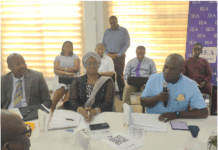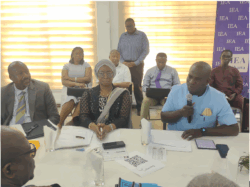A new analysis released by United Nations International Children’s Emergency Fund (UNICEF) has revealed that one in five children in Ghana experience high or extremely high-water vulnerability, and about four in five people may be drinking faecally contaminated water at the point of use.
The analysis, part of the ‘Water Security for All initiative’, identifies areas where physical water scarcity risks overlap with poor water service levels.
Communities living in these areas depend on surface water, unimproved sources, or water which can take more than 30 minutes to collect. According to a UNICEF report from 2017, almost one in four children globally will live in areas of extremely high-water stress by 2040.
In an interview with the Executive Director, Henrietta Fore, she explained that children are the biggest victims when wells dry-up; because when wells dry-up in these communities, the children are the ones who miss schools in order to fetch water. “When droughts diminish food supplies, children suffer from malnutrition and stunting. When floods hit, children fall ill from waterborne illnesses; and when water resources decline, children cannot wash their hands to fight off diseases,” she argued.
Globally, there are more than 1.42 billion people – including 450 million children around the world – living in areas of high, or extremely high, water vulnerability. This means that one in five children worldwide do not have enough water to meet their everyday needs.
The research further explained that children in 37 countries – including Afghanistan, Burkina Faso, Ethiopia, Kenya, Niger and Nigeria – face particularly dire circumstances. In such instances, she said, global resources, support and urgent action must be mobilised.
Currently, the total percentage of children experiencing high or extremely high-water vulnerability in countries which are most affected stands at 93%, 92% and 91% for Afghanistan, Kenya and Burkina Faso respectively, compared to Ghana with 21%.
Ms. Fore noted that demand for water continues to increase dramatically while resources are dwindling. She further explained that rapid population growth, urbanisation, water misuse and mismanagement, climate change and extreme weather events reduce available quantities of safe water, exacerbating water stress.
“While the impact of water scarcity can be felt by all, no one suffers more than the most vulnerable children. The world’s water crisis is not simply coming, it is here; and climate change will only make it worse. Children and families living in vulnerable communities face the double-edged sword of coping with high water scarcity levels while having the lowest water services, making access to sufficient water especially susceptible to climate shocks and extreme events,” added Ms. Fore.
In response, UNICEF is launching the Water Security for All initiative to ensure every child has access to sustainable and climate-resilient water services. The initiative aims to mobilise resources, partnerships, innovation and global response to identified hotspots where the need for safe, resilient and sustainable water, sanitation and hygiene services is the greatest and most urgent.
UNICEF is working to provide safe and affordable drinking water services that are sustainable, close to home, and managed professionally. UNICEF is also working to provide water, sanitation and hygiene services that withstand climate shocks, operate using low carbon energy sources, and strengthen communities’ resilience and adaptive capacities.
Again, UNICEF will be providing resources assessments, sustainable water withdrawal, efficient use, and early warning and early preventative measures; as well as support communities and key stakeholders so that equitable management of water, sanitation and hygiene services increase social cohesion, political stability and peace; and in conflict zones, to prevent attacks on water and sanitation infrastructure and personnel.
Henrietta Fore admonished: “We have to act now, both to address the water crisis and prevent it from getting any worse. We can only achieve water security for every child through innovation, investment and collaboration; and by ensuring services are sustainable and resilient to climate shocks. For our children and our planet, we have to act.”










